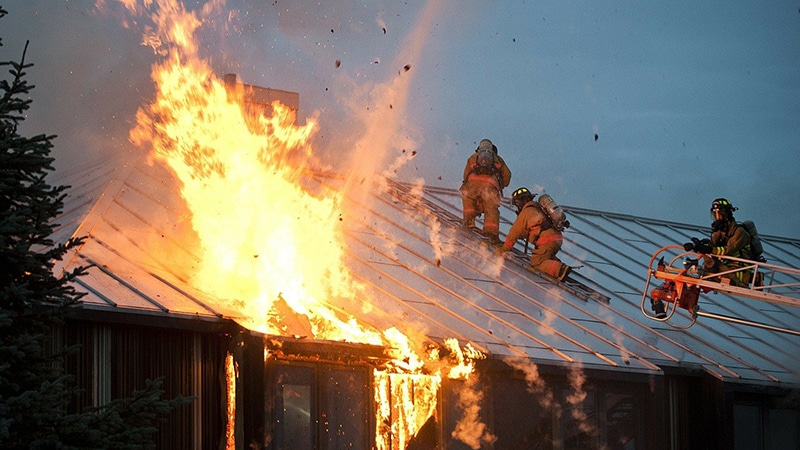The term “spontaneous combustion” is often met with anxiety and confusion by many homeowners. We assume that our properties are safe from the threat of suddenly bursting into flame. However, the reality is that spontaneous combustion is a significant risk in garage workshops, farms, and everyday homes alike. Indeed, spontaneous fires are the cause of many destroyed buildings.
The good news is that the name “spontaneous combustion” is a little misleading. Homes generally don’t erupt into flames at random. Instead, fires happen somewhat spontaneously when the right ingredients are in close proximity.
Here’s what you need to know about preventing spontaneous combustion.
Why Does Spontaneous Combustion Happen?
All fires, including those caused by spontaneous combustion, occur because of access to fuel, heat, and oxygen. Normally, we think of heat as something like an open flame. However, in spontaneous combustion, a flame isn’t the issue. Rather, chemical reactions and other issues cause the heat.
Spontaneous combustion is particularly common when flammable finishes on items around the home (like linseed oil) combine with oxygen and air. These oils create a chemical reaction that creates heat. In farm situations, the chemical reaction can involve the addition of organic materials like hay. In the home environment, chemical reactions can include amplified sunlight (directed through glass) and various cleaning chemicals.
The unsaturated compounds in carbon-based vegetable and animal oils can be hazardous when residue-infused combustible materials aren’t disposed of appropriately or if they come in contact with additional combustible materials. Spontaneous heating doesn’t result from saturated hydrocarbon materials (like grease, diesel fuel, gasoline, and motor oil). Their chemical makeup doesn’t have a double bond to react with the oxygen in the air and create heat.
Open-air environments rarely suffer from issues with spontaneous combustion because the heat can easily dissipate. Heat is not able to build to a temperature in an open-air environment that would ignite materials. That said, when oxidizing chemical reactions are confined to stop the heat from dissipating, ignition can happen.
How Do You Prevent Spontaneous Combustion?
Like most strategies for protecting your home, preventing spontaneous combustion requires some caution and careful planning on the part of the homeowner. Whenever you create a new chair in your office at home and use a rag to apply a finishing oil, hang it up to dry outdoors. Don’t leave your rags bunched up together in an area where they may be exposed to additional heat.
If you’re keeping oily rags or other flammable substances indoors, make sure they’re situated far enough away from any sources of heat. If you’re planning on working on home projects like building your own furniture, or you’re a contractor who regularly deals with flammable items, remember to follow these tips:
- Always read and adhere to the warnings and directions printed on your paint, cleaning, and staining products, particularly regarding storage.
- Dispose of brushes, rags, and similar items in a container approved to be non-flammable. You can also place these items outside to allow them to dry out.
- Never throw used rags into a plastic bucket, and store solvents and paints away from heat-producing appliances like water heaters and furnaces.
- Store mulch, compost, and other sources of “kindling” far away from any buildings when looking after your garden.
- If laundering clothing is soaked in various flammable liquids, make sure you clean the items thoroughly. Standard wash cycles will not always remove all of the fluid. Drying these items in a tumble dryer at high heat could cause a fire.
- Debris from sanding, as well as filters and sanding equipment, must always be disposed of according to the instructions provided by the manufacturer. Get rid of any dust or sawdust as quickly as possible to prevent fire.
- If you’re storing oil-soaked or flammable products indoors, make sure you don’t pile too many items together or place them in a confined space. Keep any flammable items away from sources of heat, including radiators and windows.
- Be cautious about window magnification. Ensure none of the glasses, windows, or other items in your home magnify the rays of the sun in such a way that they create extra sources of heat around flammable items.
- Install self-closing lids on metal containers and keep them away from the residence in an area clear of brush and organic materials.
If anything catches fire in your home, including flammable rags and furniture, ensure you know how to deal with the issue. In most cases, you can douse the fire with water or cover it with dirt and sand if there is a lot of oil present. Don’t disturb the item until you are sure the fire is out. Keep the item outside and away from the rest of the home even after it is extinguished.
What if Spontaneous Combustion Happens?
Prevention is key, but even great care can’t always stop spontaneous combustion. If you or your property is affected by spontaneous combustion, contact our fire cleanup and damage restoration experts in Utah.
We have the experience and know-how to deal with the damage and return your life and property back to normal as quickly as possible.

